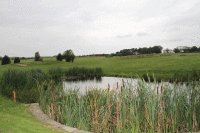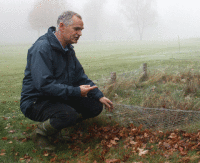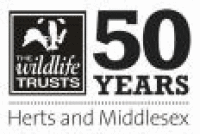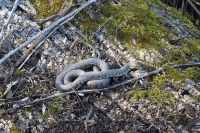A Living Landscape

Maintaining a rewarding golf course whilst satisfying the needs of wildlife is a challenge, but it's something that General Manager, Terry Crump, embraces at Harpenden Common Golf Club. The course forms a significant part of Harpenden Common, over 210 acres of woods, heathland, meadows and ponds designated as a Local Wildlife Site, so careful management to protect the wildlife is important and much welcomed by local people.
The rough and the smooth

"Cutting the rough just once a year in July or August means wildflowers have time to set seed and longer grass provides cover for birds, small mammals and insects. This creates a tougher golf course, for a period. It's obviously cheaper too as we're only cutting it once. Sometimes you get complaints as the rough gets too long but, over the years, people have got used to it. We always play our club championships prior to the long rough being cut, so it's as tough as possible!"
Bringing heather back
Harpenden Common is important for its patches of rare heathland and meadow and, on the golf course, work is being carried out to restore and increase heather and gorse.
A careful mowing regime will encourage the heather to spread. Two trial plots, where heather has been re-established, are growing well; the plots are rabbit-fenced for a period to prevent the nibbling of new shoots, but the fencing will eventually be removed once the plants are established.

Native species
A number of conifers, which act as a barrier between two holes on the course, will gradually be replaced with a broadleaved species like hornbeam, which will be much more in keeping with the local habitat. In an area of the course called the Jockey Field, Terry has plans to recreate a wildflower meadow on land that was formerly used for arable farming.
Native wildflowers, including harebells and thyme, grow in an area called the 'dell', an unexpected crater in the ground rumoured to have been dug by Harpenden Town Council to stop enemy planes landing in the Second World War!
The grass here is cut in the same way as the other meadow grass in areas of rough; once a year in late summer to allow the wildflowers to bloom and seed.
Pond

Woodland close to the pond provides overwintering places for the frogs which breed in the pond, whilst areas of adjacent rough provide feeding for dragonflies. It's the mosaic of different habitats, providing for the different parts of life cycles that means so many species live here.
The bigger picture
Sympathetic management of the golf course for wildlife is an important part of the Conservation Management Plan for the whole of Harpenden Common. Creating habitat on the golf course that links to and complements habitats on the rest of the common means more room for wildlife to disperse and adapt. Councillor Bert Pawle, Chair of Harpenden Town Council's Environment Committee, says; "We endorse and appreciate all the ongoing good work carried out on the common by Harpenden Common Golf Club, which is living proof of how a good working partnership can deliver benefits for us all. We look forward to the involvement of Herts and Middlesex Wildlife Trust in rolling out this next revision of the Conservation Management Plan."
Getting the balance right is vital - and clearly achievable. Terry thinks club members are persuaded too. "I'm sure, with the publicity that you see nationally about the need for biodiversity on golf courses, that the members realise it's important."

Herts and Middlesex Wildlife Trust is working in partnership with Harpenden Town Council on the Conservation Management Plan for Harpenden Common.
It's not practical to think that we can turn the clock back to a time before roads were laid down, rivers were canalised, houses were built, farming intensified. But there is a huge amount that we can do with the landscape we live in now, to improve and secure the future for our wildlife
Reduce chemical use
Reducing chemical use to the bare minimum can be cost-effective, whilst also benefitting wildlife. Chemical use can be optimised through soil analyses, soil nutrient management planning and targeted application rates.
The 'rough'

Wildflower-rich grasslands create an abundance of food and cover for insects, small mammals and birds. Summer flowering meadows can be created by mowing in June and again in late September. Zoning these longer areas known as the rough will benefit wildlife. Fortnightly mowing of the shorter rough will encourage low growing species like bird'sfoot trefoil. Long rough can receive much less attention, allowing taller plants to grow and set seed, and providing food and cover over winter for insects, small mammals and reptiles like grass snakes.
Heathland

Gorse, broom and heather of varying ages and sizes will benefit wildlife the most. Small, young plants provide basking spots for lizards, whilst larger shrubs provide nest sites for birds. Cutting heather with the blades fairly high will imitate the beneficial effects of a grazing herd. Tree removal will help light to reach the seedling plants and encourage growth.
Woodland and single trees
Again, variety is the key. In the past, woodlands were coppiced to provide timber for all sorts of uses; the rotational cutting of woodland 'blocks'

Pollarding (reducing the size of the crown to prevent a tree from becoming 'top heavy') of single trees will encourage more light onto previously shaded grass and result in healthier turf.
Where new planting is required, native tree species are best - and native shrubs can provide important food for insects, birds and mammals in the form of berries and flowers.
Hedgerows
Where hedges have gaps, a mixture of tree planting and traditional hedge-laying can restore them. As well as providing shelter, hedgerows act like a larder for all sorts of wildlife: nectar in the spring supports butterflies and other insects, whilst berries help small mammals and birds such as redwings and fieldfares through the winter months.

Leaving a natural edge around at least part of a pond or lake will provide cover for aquatic wildlife, whilst still allowing golfers to find lost golf balls around the close cut edge. Trees and shrubs add cover for wildlife, although overhanging trees should be cut back on the south side of ponds and lakes to allow enough light in.
Habitat variety
Courses with lots of different types of habitat will attract the most wildlife. Bats will benefit from open grassy areas and expanses of water for feeding, and roost in the trunks of old trees. Grass snakes are particularly suited to golf courses - plenty of water and long grass to hunt in, the sunny bank of a bunker to bask on and compost heaps to lay their eggs in all make a perfect home!
Steps to follow:

Step 2: Identify the potential opportunities for habitat creation and connectivity between existing habitat patches
Step3: Build into the masterplan a functioning natural habitat network as key infrastructure
Look for synergies with other features such as paths, cycleways and public open spaces
Step 4: Create a long-term management plan for the enhancement and maintenance of the existing and proposed new habitats
Each of the forty-seven Wildlife Trusts is an independent, autonomous charity with its own trustees, whose primary concern is the conservation of nature within its own geographical area www.wildlifetrusts.org
